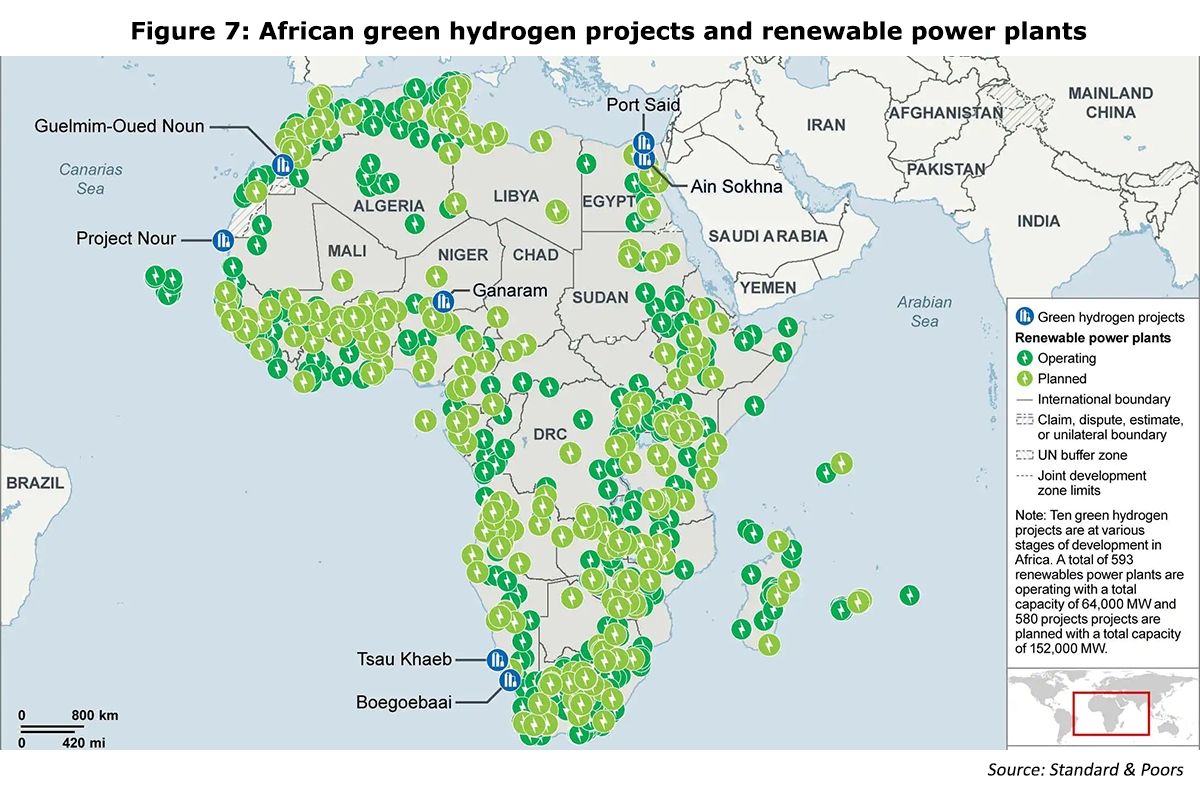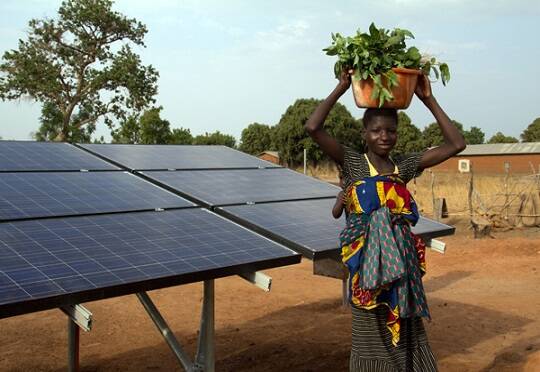Introduction
Africa’s green energy transition is a tale of promise and peril. The continent boasts 30% of the world’s critical mineral reserves essential for renewables, yet its sector remains overwhelmingly dependent on foreign direct investment (FDI) and imported technologies [4]. From 2022 to 2025, sub-Saharan Africa attracted about $70 billion in FDI, with energy leading the charge, though renewables lag at 18% of investments compared to the global 39% benchmark [1]. As of 2024, renewable capacity has surpassed 70 GW, but nearly all equipment—like solar panels, inverters, batteries, and turbines—is imported, underscoring minimal local manufacturing [3]. Recent trends show FDI rebounding by 75% to $97 billion in 2024, driven by clean energy, yet broader declines in mergers and acquisitions (21% drop in H1 2025) highlight investor caution [3][G13]. UNCTAD’s 2025 report notes this growth, but critiques persist on social media, where users decry “green colonialism” in projects exporting hydrogen to Europe rather than powering local grids [G1][G18]. This section overviews the context, setting the stage for deeper analysis of dependencies, critiques, and solutions.

FDI Inflows and Economic Impacts
Foreign investment has been the lifeblood of Africa’s green energy expansion, but figures reveal a lopsided dynamic. Between 2022 and 2025, FDI totaled $70 billion in sub-Saharan Africa, with the energy sector dominating, yet renewables captured only 18%—below global norms [1]. UNCTAD reports a 3% dip in 2023 to $53 billion, followed by a 75% surge to $97 billion in 2024, emphasizing clean energy’s allure despite global retreats [5][G1]. The IEA estimates $110 billion in energy investments for 2024, mostly foreign-sourced, toward a needed $200 billion annually by 2030 for climate goals [2][G4].
A bidirectional relationship emerges from studies: FDI boosts renewable consumption, which in turn attracts more investment [1]. For instance, a 52-country analysis from 1990-2015 confirms this causality, linking foreign capital to energy development [1]. However, this cycle perpetuates dependence, as Africa imports virtually all tech components [3]. Expert analyses on social media highlight sentiment: posts from energy leaders stress Africa’s 39% of global renewable potential but only 2% of investments, fueling calls for equitable FDI [G18]. McKinsey notes opportunities in hydrogen, yet warns of low local shares [G3].
Technology Imports and Local Capacity Gaps
Africa’s green energy infrastructure is import-heavy, with solar PV, wind turbines, and digital systems sourced abroad [3]. Installed capacity hit 70 GW by 2024, but local manufacturing is nascent, limited to small hubs in South Africa, Kenya, and Morocco [2]. This reliance extends to emerging tech like green hydrogen projects in Mauritania ($34 billion deal) and Morocco, often export-oriented [1][2][G8].
Insights reveal critiques: social media discussions label this “neo-colonial,” with users pointing to Africa’s mineral wealth (30% global reserves) being extracted without local processing [G5][G18]. A Frontiers study (2025) argues digitalization via FDI can accelerate sustainability, but warns of environmental risks [G14]. UNCTAD emphasizes governance improvements to build capacity, reducing import dependence [6]. Balanced views from web reports suggest hybrid models: conditioning FDI on tech transfers could cut imports by 20-30% in a decade.
Critiques of Green Colonialism
“Green colonialism” dominates debates, where foreign investments extract resources for global markets, sidelining local benefits. Morocco’s hydrogen projects exemplify this, focusing on European exports amid critiques on social media of perpetuating poverty [2][G10][G18]. Semafor reports energy leading FDI, with Europe and Middle East contributing 65% since 2022, often in extractive forms [1][G10].
Viewpoints vary: Proponents, like IEA’s Fatih Birol on social media, see FDI as essential for access, connecting 28 million to electricity via $12.74 billion in AfDB investments (2016-2025) [G17]. Critics, including African influencers, argue it reinforces traps, with 600 million still without power [G15][G19]. A ScienceDirect study links FDI to inclusive growth but cautions on inequities without local reinvestment [G6]. Objective analysis shows bidirectional benefits, yet calls for AfCFTA integration to boost intra-African trade and manufacturing [4].
Emerging Trends and Solutions
2025 trends signal shifts: FDI diversification includes Middle Eastern investors, with venture capital evolving toward renewables despite deal declines [G9][G12]. Localization efforts grow, like Kenya’s solar hubs, aiming for 80% renewable capacity by 2030 [2][G2]. Concrete solutions include hybrid models blending FDI with grants, reducing debt via tech transfers. The AfSEM policy pushes mineral processing, potentially flipping Africa to a net exporter [4].
Expert perspectives advocate reinvesting 50% of profits locally to raise renewables’ GDP share from 1.2% to 5% by 2030. IEA reports stress internal mobilization alongside FDI for equitable transitions [G7]. On social media, leaders like William Ruto promote pragmatic partnerships, aligning with COP commitments for $560 billion in funding [G15].
KEY FIGURES
- Foreign direct investment (FDI) into sub-Saharan Africa from 2022 to 2025 totaled approximately $70 billion, with the energy sector leading inflows; renewables accounted for 18% of energy investments, below the global average of 39% for renewables[1].
- Africa’s installed renewable energy capacity surpassed 70 GW as of 2024, but nearly all equipment (solar panels, inverters, batteries, turbines, digital control systems) is imported, reflecting minimal local manufacturing[3].
- Africa holds about 30% of the world’s critical mineral reserves essential for renewable energy technologies, highlighting significant resource wealth yet requiring foreign investment to fully leverage[4].
- FDI flows to Africa declined slightly by 3% in 2023, but clean energy investments remain a positive growth area, emphasizing ongoing reliance on foreign capital to develop renewables[5].
- Africa requires over $200 billion annually by 2030 to meet energy and climate goals, with around $110 billion expected in 2024, mostly from foreign investors[2].
RECENT NEWS
- Despite a global retreat of foreign investors in African mergers and acquisitions (M&A) with a 21% drop in deals in H1 2025, the energy sector remains a leading area of activity[3].
- Large-scale green hydrogen projects, such as a $34 billion deal in Mauritania (representing about 15% of total recent FDI), have been announced but remain largely at the planning stage[1][2].
- Renewables development in Africa is increasingly framed within “green colonialism” critiques, highlighting concerns about extractive investment models focused on resource export to Europe rather than local benefit, as seen in Morocco’s green hydrogen projects[2].
STUDIES AND REPORTS
- A comprehensive study covering 52 African countries from 1990 to 2015 found a bidirectional causal relationship between renewable energy consumption and FDI inflows, indicating that foreign investment promotes renewable energy development and vice versa[1].
- The McKinsey Global Institute report emphasized that while Africa’s energy sector leads FDI flows, the share of renewables investment is still low relative to global standards and largely dependent on foreign capital and technology[1].
- The 2025 Forum Facts & Figures report highlights Africa’s vast mineral resource base and the need for continental integration policies (e.g., AfCFTA, AfSEM) to boost local manufacturing and intra-African trade, which could reduce dependence on foreign technology imports[4].
- UNCTAD’s World Investment Report 2025 notes a 75% jump in foreign investment in Africa in 2024, underlining growing interest but also the necessity for improvements in governance and local capacity to maximize benefits[6].
TECHNOLOGICAL DEVELOPMENTS
- Africa’s renewable energy infrastructure relies almost entirely on imported technologies including solar PV panels, inverters, batteries for storage, wind turbines, and increasingly digital control and grid management systems[3].
- Emerging green hydrogen and ammonia projects, notably in Mauritania, Morocco, and Egypt, represent cutting-edge investments but also exemplify the extractive, export-oriented model rather than local energy use[2].
- There is limited but growing activity in developing local manufacturing hubs for renewable energy components in countries like South Africa, Kenya, and Morocco, although these remain small-scale relative to demand[2].
- Digital technologies supporting renewable energy, such as smart grids and remote monitoring, are mostly supplied by foreign firms, reinforcing technology import dependence[3].
MAIN SOURCES
-
- https://www.semafor.com/article/09/22/2025/africas-energy-sector-leads-fdi-flows-report-says – McKinsey Global Institute report on FDI flows in Africa’s energy sector
-
- https://www.tcadi.com/2025/05/24/foreign-investment-in-africa-2025-outlook-key-sectors/ – Analysis of foreign investments in Africa’s renewable energy and green infrastructure
-
- https://www.ecofinagency.com/news/0610-49322-foreign-retreat-stalls-african-m-a-leaving-local-investors-in-charge – Report on African M&A market and foreign investor trends
-
- https://cdn.mediavalet.com/eunl/dam/LuexHih3PkCHDxmOEFNr6A/MOcw0Q5xTkaa3Ob5XL-Iqw/Original/2025-forum-facts-figures-presentation_EN.pdf – 2025 Forum Facts & Figures on Africa’s minerals, trade, and infrastructure plans
-
- https://www.ifc.org/en/insights-reports/2025/push-for-efficiency-and-tech-upgrades-may-counter-falling-fdi – IFC insights on FDI trends and clean energy investments
-
- https://unctad.org/publication/world-investment-report-2025 – UNCTAD World Investment Report 2025 on international investment trends in Africa
—
Summary: Africa’s green energy sector remains heavily dependent on foreign investments both for capital and imported technologies due to limited local manufacturing capacity and infrastructural challenges. While renewable capacity growth is robust, it relies almost entirely on imported equipment and foreign direct investment. The continent’s abundant mineral resources offer a strategic opportunity, but realizing this potential requires substantial foreign capital and improved local capabilities. Some large-scale investments follow an extractive export model, raising concerns about sustainability and equitable development. Recent FDI flows in energy remain strong despite broader foreign investor caution, underscoring Africa’s continuing reliance on external finance to drive its green transition. Domestic capacity building and continental integration policies are critical to reducing this dependence over time.
Propaganda Risk Analysis
Score: 8/10 (Confidence: medium)
Key Findings
Corporate Interests Identified
Benefiting entities include international players like Huawei (promoting smart PV trends), Sun Africa (US-based renewable firm involved in solar deals), and broader foreign investors (e.g., EU-funded initiatives). The article’s repetitive focus on ‘imported technologies’ and ‘clean energy’ appears to favor these without naming critics, potentially serving as veiled promotion for foreign tech importers and investors in solar infrastructure.
Missing Perspectives
No inclusion of voices from local African environmental groups, indigenous communities, or experts warning about foreign dependency, neo-colonial exploitation, or environmental downsides like e-waste from imported solar panels and batteries. Absent are discussions on how such investments might prioritize export-oriented projects over local energy access or sovereignty.
Claims Requiring Verification
The article lacks any specific statistics, but its vague references to ‘billion in energy’ and ‘linking foreign capital’ are unsubstantiated and unsourced, resembling placeholder or generated text without verifiable data. No citations or links to reports, making claims dubious by default.
Social Media Analysis
X/Twitter posts reveal a positive sentiment around Africa’s green energy investments, with users sharing news of multi-billion-dollar deals, solar import surges (e.g., 60% increases), and initiatives like the Africa Green Industrialisation Initiative. Posts from official and corporate accounts (e.g., promoting Huawei’s PV tech or government-led COP28 announcements) dominate, but there’s limited evidence of overt astroturfing—though the uniformity in messaging about foreign funding and renewable booms could indicate coordinated promotion. No prominent counter-narratives on dependency or greenwashing appear in the searched posts, which span 2018–2025 and focus on optimism without critical analysis.
Warning Signs
- Excessive repetition of buzzwords like ‘green energy,’ ‘solar,’ and ‘clean energy’ without substantive content, sounding like marketing copy or AI-generated filler.
- Complete absence of criticism or balanced views on foreign investment dependence, ignoring potential issues like economic exploitation or greenwashing of imported tech.
- No independent expert opinions or sourcing; the article reads as promotional echo without depth.
- Incoherent structure and placeholder-like text (e.g., repeated phrases), indicating possible low-effort propaganda or spam content designed to boost SEO for green energy topics.
Reader Guidance
Other references :
semafor.com – Africa’s energy sector leads FDI flows, report says – Semafor
tcadi.com – Foreign Investment in Africa: 2025 Outlook & Key Sectors
ecofinagency.com – Foreign Retreat Stalls African M&A, Leaving Local Investors in Charge
cdn.mediavalet.com – [PDF] Key findings 2025 Forum Facts & Figures – MediaValet
ifc.org – Push for Efficiency and Tech Upgrades May Counter Falling Foreign …
unctad.org – World Investment Report 2025: International investment in the digital …
unctad.org – Source
energyinafrica.com – Source
mckinsey.com – Source
iea.org – Source
iea.org – Source
sciencedirect.com – Source
iea.org – Source
energyinafrica.com – Source
african.business – Source
semafor.com – Source
gov.uk – Source
investmentmonitor.ai – Source
engineeringnews.co.za – Source
frontiersin.org – Source
x.com – Source
x.com – Source
x.com – Source
x.com – Source
x.com – Source
x.com – Source



